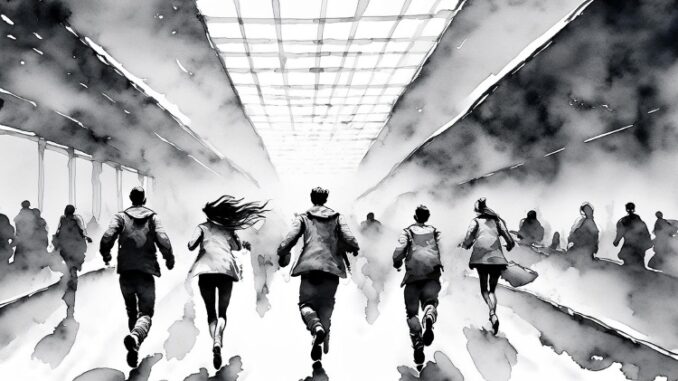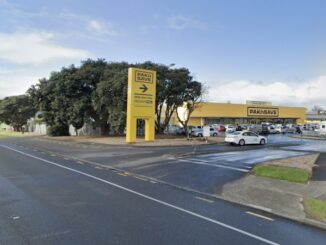
The Sydney tragedy leaves us with the question of how to react to extremely low probability events with potential catastrophic consequences, writes Dr John Battersby of Massey University’s Centre for Defence and Security Studies.
On 13 April 2024 a lone male carried out a vicious attack in a West Sydney shopping mall. Six people perished as a result of the injuries he inflicted before a police officer shot him. For the deceased victims’ families and the injured baby, who survived, but will now be without a mother, this was a dreadful tragedy.
For the police officer, despite being hailed a hero, this event will have lifelong consequences – no one joins a police service to kill people. Regardless of the circumstances, harming people is not something police take any pride in doing.
For the media, this event was manna from heaven generating day on day copy. The victims included a mum, a bride to be, a student from China – all with immense potential lives to live, cut down in their prime by the senseless actions of one individual. The perpetrator himself became the subject of sensationalised speculation – was he ideologically driven? Did he hate women? He was an escort apparently. Then a gay escort.
“the Bondi Junction Mall attack illustrates two key points: (i) the vulnerability of such environments to any attacker, providing congregations of unsuspecting people with limited points of escape, and (ii) the potency of armed police officers in stopping an attack.”
The police officer, a female inspector, alone, calm under immense pressure, acted decisively, and she did not miss. She was shown after the event taking care of the man she shot, precisely as she would have been trained to do. There were days of compelling media fodder here amplifying and elongating the tragedy.
But what are the wider implications of this event? While likely to be considered one of those things that will never happen here – might it? Could we do anything about preventing it?
Understanding the facts
Our first task is to remove the incident from the sensational media-driven milieu within which public understanding was framed and place it back into the reality in which it happened. No assessment can take place until key facts have been verified, assumptions identified, and knowledge gaps determined.
Sydney is a city with a population the size of New Zealand. Sydney has hundreds of malls, shopping centres, and retail spaces in which thousands of people congregate every day. These routine congregations almost always pass without incident, other than petty crime, isolated and occasional disorder, the vast bulk of which creates no existential risk or actual harm to the general public.
On 13 April 2024 there was a clear exception – but even so public place mass killings are rare in Australia and very unusual with an offender using a knife. Knife mass killings occurred in December 2014 and September 2018 in Australia – both were associated with domestic incidents.
Knives have been used globally in ideologically inspired attacks, as have motor vehicles as improvised weapons, but their media profile is vastly out of proportion with their actual frequency. Knife attacks by terrorists, violent extremists or non-ideological perpetrators are very unusual.
From this we can depict 13 April 2024 as a highly uncharacteristic event, very unlikely to recur in Australia, let alone anywhere else. The offender Joel Cauchi is dead, and dead men tell no tales. We will never know what triggered him, or what motives he had in doing what he did.
His decision appears to have been spontaneous, he did not leave a note, or a manifesto explaining his actions, and a number of people interviewed by media sources, who knew him, seemed genuinely surprised at what he did. His motives will remain a subject of speculation.
Cauchi used a knife, which supports the notion of improvisation and limited planning. He wore an Australian Rugby League jersey, an everyday item and hardly a statement-maker. He has therefore taken no action to acquire anything symbolic that might suggest a message of any kind. The evidence suggests he acted by himself, apparently without any desire to trigger a connection with anybody else.
He did appear to target females, prompting a worthy line of inquiry regarding a possible misogynistic or incel-related motive. But we need to know what the demographic was inside the mall – were there more women than men in there?
We need to know how many people he attacked (not just killed); there has been very little information provided about twelve people apparently injured. He did kill one male, and CCTV images showed another one fending off Cauchi.
We need to be careful of commentators with agendas framing the incident in way that serves their purposes. Our initial assessment then has to be, unless information emerges to the contrary, this was an attack inspired somewhere deep within Cauchi’s troubled mind, and not related to any broader ideological cause.
Does this event mean anything for us here in New Zealand?
New Zealand has about 100 major malls or shopping centres across the country. Our largest city, Auckland, has a population of 1.5 million people, and it likely has most of the larger public/private commercial spaces in which people congregate.
Mass killings in New Zealand are extremely rare, and the only one involving a knife was during a domestic incident in Masterton in 1992. Two knife attacks have occurred in circumstances where a mass killing could have resulted, both occurring in supermarkets in 2021. One was ideologically driven in Lynn Mall, and one in Dunedin.
While both received media attention, the Lynn Mall attack has received a disproportionate amount likely due to its perpetrator, Ahamed Samsudeen, being inspired by ISIS propaganda.
There are over 3,800 supermarkets in New Zealand. The sober assessment has to be therefore, that in 2021, following years without any notable incident, there were two out of over 3,800 supermarkets that experienced a knife attack incident.
To be fair, the Lynn Mall offender was known to police and if New Zealand had counter terrorism legislation that was actually functional – arguably it wouldn’t have happened.
Any sober analysis results in a conclusion that a mass-killing or mass-injury knife attack is extremely unlikely in any public/private commercial space in New Zealand.
However, the Bondi Junction Mall attack (in tandem with the Lynn Mall attack) illustrates two key points: (i) the vulnerability of such environments to any attacker, providing congregations of unsuspecting people with limited points of escape, and (ii) the potency of armed police officers in stopping an attack. This latter point is significant as New Zealand police officers, while they have access to firearms, are not routinely armed.
We are left with a question how to we react to a problem of an extremely low probability event, with potential catastrophic consequences, occurring within the confines of a busy New Zealand shopping mall on any given day of the week by an active armed offender. A few things seem certain:
- the motive of the offender is irrelevant, an attacker is deadly because they are armed and have an intent to do harm (the reason why they do it will not affect the lethality of their attack).
- Police are unlikely to be present in a New Zealand mall at the time of any attack; and they would NOT be armed if they were. A police response time of 10-15 minutes could be expected in most areas,
- most malls have limited entrances and exits, complicating a panicked escape of customers, and
- while almost all malls have security guards, the death of Faraz Tahir in Sydney, demonstrates the fatal consequences of them attempting to intervene.
Clearly, while highly unlikely, such an attack could have serious and fatal results. However, we seem to be left with limited options when contemplating what to do about such an event.
So, we could do nothing. The likelihood of anything similar to the Westfield Bondi Junction attack happening here has vastly greater odds than winning lotto. There are serious limitations (not to mention costs) to what we could do anyway, and this would weigh against any practical action that could be undertaken.
Honestly, the safest prediction is that the Westfield Bondi Junction Mall attack will go down as an aberration of modern urban life and remain a horrible and singular tragedy. We will all move on.
Or alternatively, we could take a serious look at our public/private spaces in terms of a major unexpected event, and link this to the suppression of serious crime generally. Daylight ram raids – or other raiding incidents – present no less of a risk to the public in terms of potential harm and are significantly more likely to occur.
We could look at reviewing what the role of security guards are in New Zealand, and what we need to better equip or empower them.
There must he scope for improved communication and cooperation between police and public/private space operators looking at the possibility of more visible police patrols, detection, and monitoring of suspicious behaviour, and coordinated contingency planning for unexpected events.
Ultimately, we cannot stop the emergence of an active armed offender intent on causing a mass casualty event, and it is highly unlikely such an individual will be detected before they have inflicted harm. It remains a risk, albeit a remote one. But there does seem scope at least for us to attempt to take seriously the possibility that it could occur and put some mitigations in place – especially if they overlap with other crime control or public safety initiatives.









